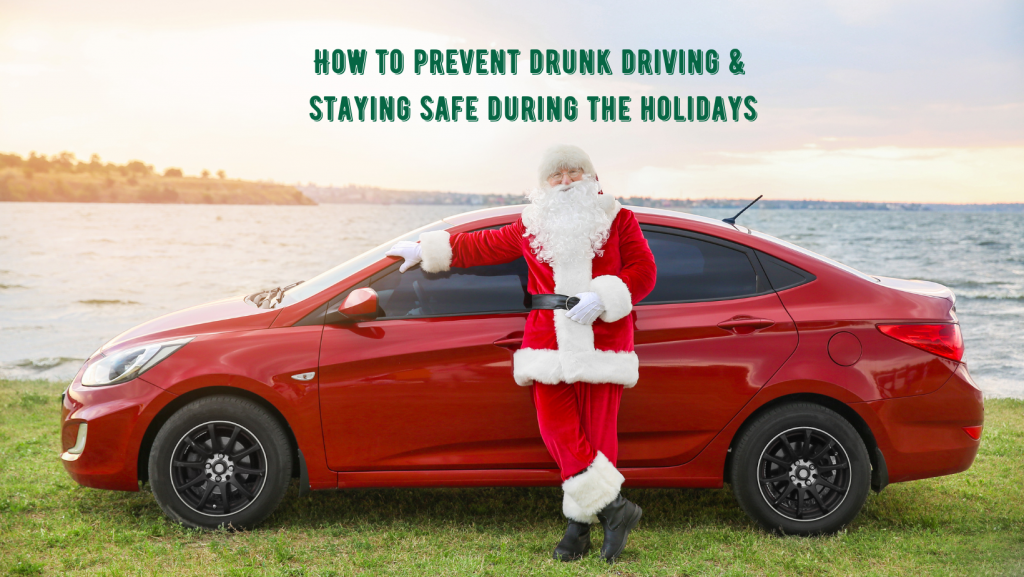How To Prevent Drunk Driving And Stay Safe During The Holidays
How to prevent drunk driving and staying safe during the holidays.
Every 39 minutes, someone loses their life to drunk driving in the US. According to MADD, 2 in 3 people will be involved in a drunk driving accident in their lifetime. The likelihood of this happening to you, a friend, or a family member only increases around the winter holidays.
This is not only because driving is the most popular way to travel during the holiday periods, but also because the average American doubles their alcohol consumption during this time. Coupled with less daylight hours, worse weather conditions, and increased stress levels, these factors make driving during the holidays more dangerous.
Let’s look at some sobering facts and statistics about driving under the influence—and the best ways to prevent it.

Drunk driving statistics
During the winter holidays, 40% of all highway deaths are linked to drunk driving. In 2020, 209 drunk driving-related fatalities occurred in the period spanning from Christmas to New Year’s Day.
New Year’s Eve is the day with the highest amount of alcohol-related driving fatalities. However, New Year’s Day is the most dangerous day of the year for pedestrians, who may be hit by an impaired driver.
Aside from just fatalities, an estimated 25,000 injuries occur from drunk driving every year in the period from Thanksgiving to New Year’s Day.
Combined, these injuries, fatalities, and the resulting car and property damage from drunk driving cost Americans more than $44 billion annually.
Approximately one-third of all car crash fatalities in the US involve drunk drivers, according to the NHTSA. To show even more how common these incidents are, 1 in 222 licensed drivers in the US will be arrested at some point in their lives for driving under the influence.
Which states have the most drunk driving accidents?
Breaking it down by state, Montana is the deadliest for alcohol-related crashes during the holiday season per capita. The second deadliest is South Carolina, and then New Mexico.
On Christmas Day 2019, the states with the highest rates of drunk driving-related deaths were New Mexico, Louisiana, and Alaska.
For New Year’s 2019, the states with the highest rates were South Carolina, New Mexico, and Rhode Island.
In most states, the legal blood alcohol limit is 0.08%, but in Utah it is 0.05%. Depending on where you live, driving under the influence results in a DUI charge, possible jail time, fines, insurance increases, license suspension, or the installation of an ignition lock system on your car. Many local law enforcement agencies have “no refusal” laws, which means any person pulled over must submit to an alcohol screening if suspected of DUI. How to prevent drunk driving and staying safe during the holidays.
Drunk driving myths
Unfortunately, many common myths and incorrect ideas about drunk driving pervade our culture. Here are a few you might hear:
- “Coffee will sober me up.” This is incorrect. The CDC warns against mixing alcohol with caffeine, as the stimulant in coffee may make you feel more alert, masking the depressant effect of alcohol. However, caffeine has no effect on the metabolism of your liver—it doesn’t impact your blood alcohol concentration.
- “It’s been an hour since I stopped drinking, so I can drive.” On average, it takes about one hour to metabolize one standard drink. However, the quantity that you drink at a holiday party might be significantly higher, so it may take much longer. The speed at which you metabolize alcohol is also dependent on factors like your weight, what food you’ve eaten, and how tired you are.
- “I can drive because I’m not slurring my words.” Your driving ability is compromised long before your ability to speak is affected when drinking.
Help keep yourself, your friends, and your family safe by debunking these myths.
Preventing drunk driving accidents
The best way to prevent drunk driving is to make sure everyone attending your holiday celebration has a plan to get home safely—or spend the night so they don’t have to worry about transportation.
Having a designated driver who doesn’t drink, relying on public transportation, or using rideshare apps like Uber and Lyft are a few good options. If you notice your friends or family members attempting to get into the driver’s seat while intoxicated, take away their keys and find them an alternative means of getting home.
Many Americans don’t recognize when they’re binge drinking, which can have very dangerous outcomes. Keep track of how much you’re drinking and encourage your friends and family to do the same. If you’re staying sober, you can help keep tabs on others.
Many people also overestimate their ability to drive while drunk. Remind your friends and family that even if they feel like they can drive, they should not.
When you’re on the road, there are a few ways to protect yourself from potential drunk drivers. If you see a driver on the road that appears impaired, contact local law enforcement immediately.
When possible, avoid driving late at night—if you have a long drive home, stop for the night if you can. Not only will this lower the likelihood of you encountering a drunk driver, but it will also keep you awake and alert.
Before any holiday travel, check your car for maintenance issues. This will avoid the need to pull over—highway shoulders are extremely dangerous, especially when more drunk drivers are on the road. Prepare your car for winter weather, too.
You can also take a defensive driving course to learn more about highway safety. Also make sure you always wear your seat belt and get plenty of sleep.
Since 1980, drunk driving incidents have decreased by 50%, but they are still quite common. Take care of yourself, your friends, and your family to prevent these accidents and save lives.
How to prevent drunk driving and staying safe during the holidays.
